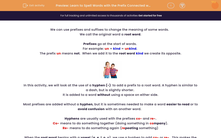We can use prefixes and suffixes to change the meaning of some words.
We call the original word a root word.
Prefixes go at the start of words.
For example: un + kind = unkind.
The prefix un means not. When we add it to the root word kind we create its opposite.

In this activity, we will look at the use of a hyphen (-) to add a prefix to a root word. A hyphen is similar to a dash, but is slightly shorter.
It is added to a word without using a space on either side.
Most prefixes are added without a hyphen, but it is sometimes needed to make a word easier to read or to avoid confusion with an another word.
Hyphens are usually used with the prefixes co- and re-.
Co- means to do something together (doing something in company).
Re- means to do something again (repeating something)
When the root word begins with a vowel (a, e, i, o, u), we use a hyphen to add co- or re-. This makes the word easier to read.
For example: re-enter, co-author
However, sometimes it is acceptable to omit the hyphen even if the root word starts with a vowel.
This can be a bit confusing, but you will see both spellings accepted for words such as coordinate and co-ordinate.
We also use a hyphen when, without it, the word would be confused with another.
For example: re-cover means to cover again but recover means to get better.

If neither of these rules apply, we can add the prefix without a hyphen.
For example: rebuild
Hyphens can also be used to link two or more words to make a new one, eg three-year-old. We will not be looking at this use of the hyphen in this activity.
Here are some examples of words that we will practise in this activity.
co-ordinate or coordinate
re-enter
co-operate
co-own
re-cover
co-author
You can listen to them here:
.jpg)







